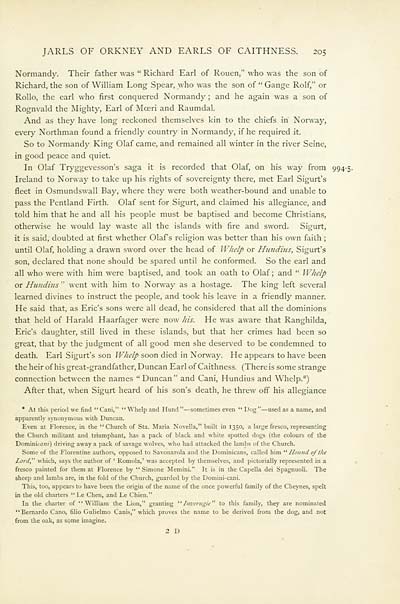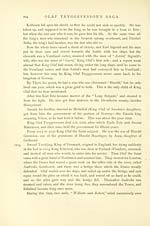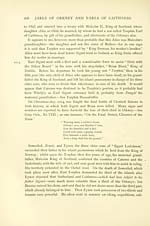Family records of the Bruces and the Cumyns
(217) Page 205
Download files
Complete book:
Individual page:
Thumbnail gallery: Grid view | List view

JARLS OF ORKNEY AND EARLS OF CAITHNESS. 205
Normandy. Their father was " Richard Earl of Rouen," who was the son of
Richard, the son of William Long Spear, who was the son of " Gauge Rolf," or
Rollo, the earl who first conquered Normandy ; and he again was a son of
Rognvald the Mighty, Earl of Mceri and Raumdal.
And as they have long reckoned themselves kin to the chiefs in Norway,
every Northman found a friendly country in Normandy, if he required it.
So to Normandy King Olaf came, and remained all winter in the river Seine,
in good peace and quiet.
In Olaf Tryggevesson's saga it is recorded that Olaf, on his way from 994-5.
Ireland to Norway to take up his rights of sovereignty there, met Earl Sigurt's
fleet in Osmundswall Bay, where they were both weather-bound and unable to
pass the Pentland Firth. Olaf sent for Sigurt, and claimed his allegiance, and
told him that he and all his people must be baptised and become Christians,
otherwise he would lay waste all the islands with fire and sword. Sigurt,
it is said, doubted at first whether Olaf's religion was better than his own faith ;
until Olaf, holding a drawn sword over the head of Whelp or Hundius, Sigurt's
son, declared that none should be spared until he conformed. So the earl and
all who were with him were baptised, and took an oath to Olaf; and " Whelp
or Hundius " went with him to Norway as a hostage. The king left several
learned divines to instruct the people, and took his leave in a friendly manner.
He said that, as Eric's sons were all dead, he considered that all the dominions
that held of Harald Haarfager were now his. He was aware that Ranghilda,
Eric's daughter, still lived in these islands, but that her crimes had been so
great, that by the judgment of all good men she deserved to be condemned to
death. Earl Sigurt's son Whelp soon died in Norway. He appears to have been
the heir of his great-grandfather, Duncan Earl of Caithness. (There is some strange
connection between the names " Duncan " and Cani, Hundius and Whelp.*)
After that, when Sigurt heard of his son's death, he threw off his allegiance
* At this period we find " Cani, " "Whelp and Hund" — sometimes even "Dog" — used as a name, and
apparently synonymous with Duncan.
Even at Florence, in the "Church of Sta. Maria Novella," built in 1350, a large fresco, representing
the Church militant and triumphant, has a pack of black and white spotted dogs (the colours of the
Dominii ani) driving away a pack of savage wolves, who had attacked the lambs of the Church.
Some of the Florentine authors, opposed to Savonarola and the Dominicans, called him " Hound of the
Lord," which, says the author of ' Romola,' was accepted by themselves, and pictorially represented in a
fresco painted for them at Florence by " Simone Memini." It is in the Capella dei Spagnuoli. The
sheep and lambs are, in the fold of the Church, guarded by the Domini-cani.
This, too, appears to have been the origin of the name of the once powerful family of the Cheynes, spelt
in the old charters " Le Chen, and Le Chien."
In the charter of "William the Lion," granting " Invaiigie" to this family, they are nominated
"Bernardo Cano, filio Gulielmo Canis," which proves the name to be derived from the dog, and not
from the oak, as some imagine.
2 D
Normandy. Their father was " Richard Earl of Rouen," who was the son of
Richard, the son of William Long Spear, who was the son of " Gauge Rolf," or
Rollo, the earl who first conquered Normandy ; and he again was a son of
Rognvald the Mighty, Earl of Mceri and Raumdal.
And as they have long reckoned themselves kin to the chiefs in Norway,
every Northman found a friendly country in Normandy, if he required it.
So to Normandy King Olaf came, and remained all winter in the river Seine,
in good peace and quiet.
In Olaf Tryggevesson's saga it is recorded that Olaf, on his way from 994-5.
Ireland to Norway to take up his rights of sovereignty there, met Earl Sigurt's
fleet in Osmundswall Bay, where they were both weather-bound and unable to
pass the Pentland Firth. Olaf sent for Sigurt, and claimed his allegiance, and
told him that he and all his people must be baptised and become Christians,
otherwise he would lay waste all the islands with fire and sword. Sigurt,
it is said, doubted at first whether Olaf's religion was better than his own faith ;
until Olaf, holding a drawn sword over the head of Whelp or Hundius, Sigurt's
son, declared that none should be spared until he conformed. So the earl and
all who were with him were baptised, and took an oath to Olaf; and " Whelp
or Hundius " went with him to Norway as a hostage. The king left several
learned divines to instruct the people, and took his leave in a friendly manner.
He said that, as Eric's sons were all dead, he considered that all the dominions
that held of Harald Haarfager were now his. He was aware that Ranghilda,
Eric's daughter, still lived in these islands, but that her crimes had been so
great, that by the judgment of all good men she deserved to be condemned to
death. Earl Sigurt's son Whelp soon died in Norway. He appears to have been
the heir of his great-grandfather, Duncan Earl of Caithness. (There is some strange
connection between the names " Duncan " and Cani, Hundius and Whelp.*)
After that, when Sigurt heard of his son's death, he threw off his allegiance
* At this period we find " Cani, " "Whelp and Hund" — sometimes even "Dog" — used as a name, and
apparently synonymous with Duncan.
Even at Florence, in the "Church of Sta. Maria Novella," built in 1350, a large fresco, representing
the Church militant and triumphant, has a pack of black and white spotted dogs (the colours of the
Dominii ani) driving away a pack of savage wolves, who had attacked the lambs of the Church.
Some of the Florentine authors, opposed to Savonarola and the Dominicans, called him " Hound of the
Lord," which, says the author of ' Romola,' was accepted by themselves, and pictorially represented in a
fresco painted for them at Florence by " Simone Memini." It is in the Capella dei Spagnuoli. The
sheep and lambs are, in the fold of the Church, guarded by the Domini-cani.
This, too, appears to have been the origin of the name of the once powerful family of the Cheynes, spelt
in the old charters " Le Chen, and Le Chien."
In the charter of "William the Lion," granting " Invaiigie" to this family, they are nominated
"Bernardo Cano, filio Gulielmo Canis," which proves the name to be derived from the dog, and not
from the oak, as some imagine.
2 D
Set display mode to:
![]() Universal Viewer |
Universal Viewer | ![]() Mirador |
Large image | Transcription
Mirador |
Large image | Transcription
Images and transcriptions on this page, including medium image downloads, may be used under the Creative Commons Attribution 4.0 International Licence unless otherwise stated. ![]()
| Histories of Scottish families > Family records of the Bruces and the Cumyns > (217) Page 205 |
|---|
| Permanent URL | https://digital.nls.uk/95073590 |
|---|
| Description | A selection of almost 400 printed items relating to the history of Scottish families, mostly dating from the 19th and early 20th centuries. Includes memoirs, genealogies and clan histories, with a few produced by emigrant families. The earliest family history goes back to AD 916. |
|---|

